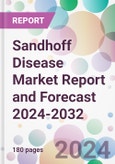Sandhoff Disease Market Outlook
The Sandhoff disease market size was valued at USD 10.18 billion in 2023, driven growing interest in gene therapy as a potential curative approach across the major markets. The market size is anticipated to grow at a CAGR of 5.87% during the forecast period of 2024-2032 and attain a value of USD 17 billion by 2032.Sandhoff Disease: Introduction
Sandhoff disease is a rare, inherited genetic disorder characterized by the harmful accumulation of certain fats (lipids) in the brain and other organs. It's caused by mutations in the HEXB gene, leading to a deficiency of the enzymes beta-hexosaminidase A and B. This deficiency results in progressive damage to the central nervous system. Symptoms appearing in infancy include motor skill deterioration, muscle weakness, and developmental delays. Sandhoff disease is severe, typically leading to early childhood mortality.Key Trends in the Sandhoff Disease Market
Ongoing research efforts are centered on developing enzyme replacement therapies to compensate for the deficient enzymes in affected individuals, aiming to slow disease progression.There's a growing interest in gene therapy as a potential curative approach, with research directed at correcting the underlying genetic mutations causing the enzyme deficiencies.
As a definitive cure is still under research, the market sees a continuous demand for supportive care products and services aimed at managing symptoms and improving the quality of life for patients. This includes mobility aids, respiratory support, and nutritional products.
Patient advocacy groups are increasingly active in raising awareness about Sandhoff disease, supporting affected families, and promoting research funding.
Recognizing the need for treatments for rare diseases like Sandhoff disease, regulatory agencies offer incentives such as longer periods of exclusivity, tax credits, and assistance with clinical trial design to encourage the development of orphan drugs.
Collaboration between biotech firms, academic institutions, and healthcare organizations is key in driving advancements in the understanding and treatment of Sandhoff disease, often supported by government grants and private investments.
Sandhoff Disease Market Segmentation
Market Breakup by Type
- Infantile
- Juvenile
- Late Onset
Market Breakup by Therapy
- Gene Therapy
- Enzyme Replacement Therapy
- Stem Cell Therapy
- Others
Market Breakup by Treatment
- Medication
- Surgery
Market Breakup by Drugs
- Market Overview
- Anticonvulsants
- Miglustat
- Others
Market Breakup by Route of Administration
- Oral
- Inhalation
- Parenteral
- Others
Market Breakup by Distribution Channel
- Hospital Pharmacy
- Retail Pharmacy
Market Breakup by Region
- United States
- EU-4 and the United Kingdom
- Germany
- France
- Italy
- Spain
- United Kingdom
- Japan
Sandhoff Disease Market Overview
In North America, the Sandhoff disease market is focused on research and the development of treatment options due to the rarity and severity of the condition. Efforts are directed towards gene therapy, enzyme replacement therapies, and other innovative approaches to manage and treat the disease. The market is also influenced by strong patient advocacy groups and support networks that drive awareness, fund research, and provide resources for affected families.Europe's market is characterized by comprehensive healthcare systems and strong regulatory support for rare disease research and treatment. The European Union has initiatives like the Orphan Drug Regulation, which encourages the development of treatments for rare diseases, including Sandhoff disease. Collaborative research across EU countries is a key factor, with a focus on developing gene therapies and understanding the disease's pathophysiology to improve patient outcomes.
Japan's market for Sandhoff disease is influenced by advanced healthcare research and a commitment to innovative treatment solutions. The country has specific programs and policies to address rare diseases, providing support for research and development of new treatments. Efforts in Japan are geared towards early diagnosis and the exploration of novel therapies, including stem cell research and enzyme replacement therapies, to provide care and potentially extend the life expectancy of those affected by the disease.
Sandhoff Disease Market: Competitor Landscape
The key features of the market report include patent analysis, grants analysis, clinical trials analysis, funding and investment analysis, partnerships, and collaborations analysis by the leading key players.- NeoImmuneTech
- Neurimmune
- GlaxoSmithKline Plc
- Sanofi SA
- Gilead Sciences
- Allergen Plc
- Novatris AG
- Abbvie Inc.
- Bristol-Myers Squibb Company
- Akero Therapeutics, Inc.
- Bristol-Myers Squibb Company
- Alexion Pharmaceuticals, Inc
- Grifols
- Intellia Therapeutics
- Ionis Pharmaceuticals, Inc.
This product will be delivered within 5-7 business days.
Table of Contents
1 Preface
3 Sandhoff Disease Overview
4 Patient Profile
5 Sandhoff Disease Epidemiology Analysis - 7MM
6 Sandhoff Disease Market Overview - 7MM
7 Sandhoff Disease Market Landscape - 7MM
8 Sandhoff Disease Challenges and Unmet Needs
10 Sandhoff Disease Market Dynamics
11 Sandhoff Disease Market Segmentation - 7MM
12 United States Sandhoff Disease Market
13 EU-4 and United Kingdom Sandhoff Disease Market
14 Japan Sandhoff Disease Market
15 Patent Analysis
16 Grants Analysis
17 Clinical Trials Analysis
18 Funding Analysis
19 Partnership and Collaborations Analysis
20 Supplier Landscape
21 Sandhoff Disease Market - Distribution Model (Additional Insight)
23 Company Competitiveness Analysis (Additional Insight)
24 Payment Methods (Additional Insight)
Companies Mentioned
- NeoImmuneTech
- Neurimmune
- GlaxoSmithKline Plc
- Sanofi SA
- Gilead Sciences
- Allergen Plc
- Novatris AG
- Abbvie Inc.
- Bristol-Myers Squibb Company
- Akero Therapeutics Inc.
- Alexion Pharmaceuticals Inc
- Grifols
- Intellia Therapeutics
- Ionis Pharmaceuticals Inc.
Table Information
| Report Attribute | Details |
|---|---|
| No. of Pages | 180 |
| Published | February 2024 |
| Forecast Period | 2024 - 2032 |
| Estimated Market Value ( USD | $ 10.8 Billion |
| Forecasted Market Value ( USD | $ 17 Billion |
| Compound Annual Growth Rate | 5.9% |
| Regions Covered | Global |
| No. of Companies Mentioned | 14 |









